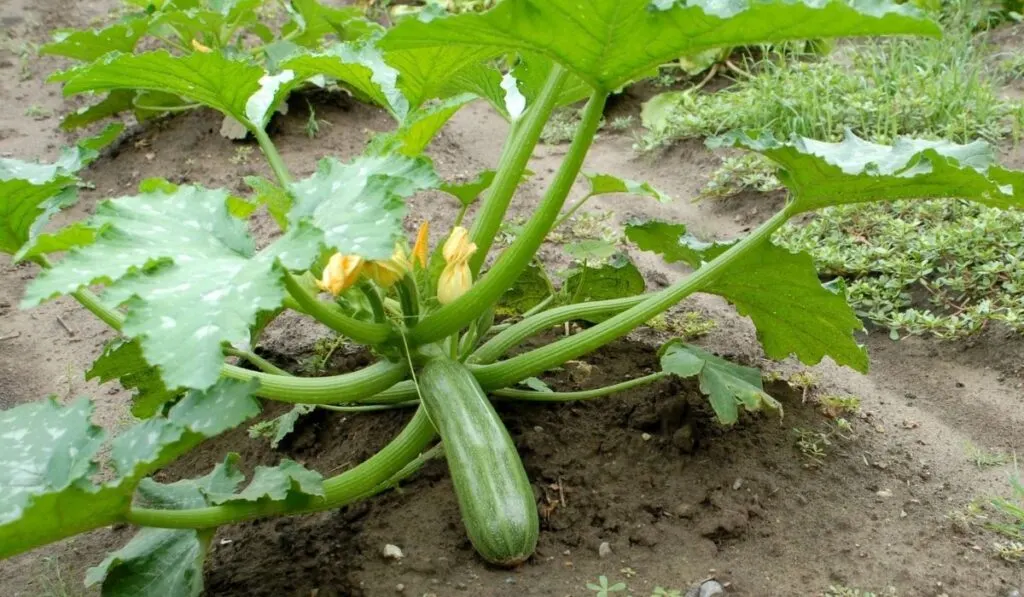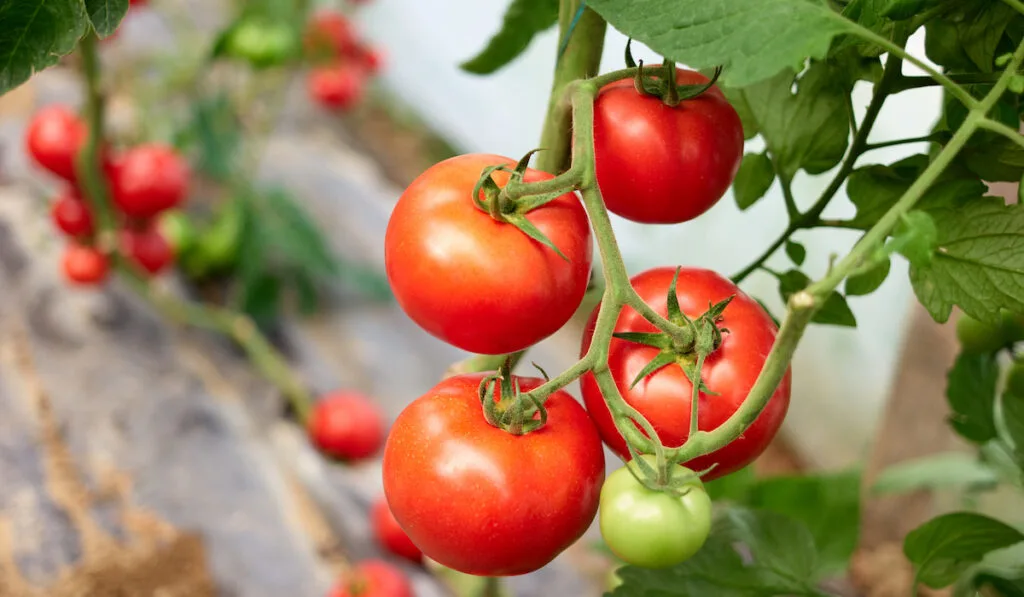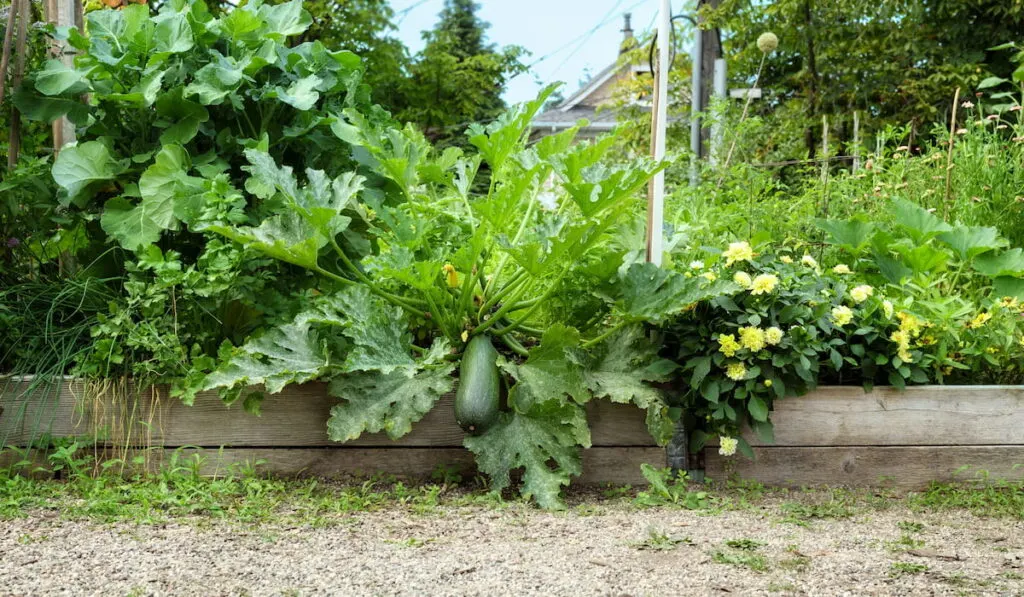Planting zucchinis and tomatoes together helps improve the efficiency of your garden space. But beyond that, is there any advantage to growing zucchinis and tomatoes in the same area?
Can zucchinis and tomatoes be planted together?
Zucchinis and tomatoes can be planted together. As expected in companion planting, these types of plants are mutually beneficial to each other.
The broad leaves of zucchinis keep the soil cool and slow the rate of soil water evaporation. The blooms of tomatoes also attract the pollinators zucchinis need to thrive.
While it is true that these plants are mutually beneficial as companion plants, it appears that there are some downsides to planting them together. We address the downsides of growing zucchinis and tomatoes together in the rest of this article. We also talk about the similarities in their planting requirements and much more.

Table of Contents
Are Tomatoes a Good Companion Plant for Zucchini?
Tomatoes are a good companion plant for zucchinis. At the same time, zucchinis are beneficial to tomatoes as a companion plant.
When tomato plants receive sufficient water and sunlight, they typically bloom within 5 to 7 weeks. Their yellow flowers precede the emergence of green tomatoes, which eventually ripen.
The yellow flowers of tomatoes attract bees. The bees attracted to tomato plants are simultaneously attracted to the zucchinis planted beside them.
Since zucchini plants must be visited by many bees/pollinators to successfully grow their fruits, having tomatoes as companion plants is a plus for them. If zucchinis do not get enough bees or pollinators around them, their fruits will stop growing and rot.
Tomatoes also enjoy some benefits when you plant them alongside zucchinis. Zucchini plants have broad leaves, and these help moderate soil temperature.
Elevated soil temperatures (above 95 degrees Fahrenheit) can reduce fruit set in tomato plants. But with the broad leaves of zucchinis, the likelihood of this happening is reduced.
Besides helping to regulate soil temperature, the broad leaves of zucchini plants can reduce the rate of soil water evaporation. Obviously, dry soil is not optimal for the growth of tomato plants.

Do They Share Similar Soil Requirements?
The general soil requirements of tomato plants and zucchini plants are similar. For one, both plants thrive in slightly acidic soil. Tomatoes grow best in pH between 6.0 and 6.8, while zucchinis do well in pH between 6.0 and 7.5.
Besides a slightly acidic pH, the soil for tomato plants and zucchinis must be well-draining. The soil must also be rich in organic matter.
Zucchinis and tomatoes are heavy feeders. So, if you intend to use them as companion plants, you must ensure the soil is very fertile. Also, you must fertilize the soil regularly.
The heavy use of soil nutrients by both types of plants is one possible downside to growing them together. You may have to spend a lot on fertilizer to keep up with their individual nutritional needs.
Zucchini and tomato plants must be planted in soil that receives around 6 to 8 hours of full sun daily. This is unsurprising since both types of plants are summer plants.
The general soil requirements of zucchini plants and tomato plants are the same. However, they also have some soil requirements unique to each other.
For one, if tomatoes are planted in soil with excess nitrogen, they will bear little or no fruits. However, their foliage will flourish.
Ideally, zucchinis should not be planted in soil that has already been used for another cucurbit. Doing so increases the chances of the transmission of soil-borne diseases.

Will Each Plant Get Enough Sun?
Tomato and zucchini plants will get enough sun if you satisfy the necessary conditions.
The most vital factor that determines the amount of sun they get is the planting site. So, if you plant your zucchinis and tomatoes in a location that receives direct sun for up to 6 hours daily, they should get enough sun.
Besides the planting site, you may want to pay attention to the broad leaves of the zucchini plants. While zucchini leaves can help regulate soil temperature and reduce soil water evaporation, they can also block the sun out.
If zucchini leaves reduce the amount of sunlight getting to zucchini and tomato plants, fruit production may fall. This is why it is vital to prune zucchini leaves.
Besides allowing each plant to get enough sun, pruning zucchini leaves prevents the formation of powdery mildew and improves air circulation. It also raises the amount of energy the fruits get.
When Should I Prune Zucchini Leaves?
Prune zucchini leaves when around 4 to 6 fruits have begun to set on the vine. At the start, nip out the tips. Then as the plant keeps growing, keep pruning as needed.
Whatever you do, avoid pruning too close to immature fruits.

What Types of Tomato Are Best Grown With Zucchini?
The types of tomatoes best grown with zucchinis are dependent on a couple of factors, including size, disease resistance, and nutritional needs.
Size
As we already mentioned, the broad leaves of zucchini plants can hinder the exposure of both plants to sunlight. So, it is more practical to grow a tomato variety that does not grow too big.
Going by this, determinate tomatoes are better with zucchinis than indeterminate tomatoes. Determinate tomatoes grow to a specific height then stop growing. But indeterminate tomatoes keep growing until winter comes or until they are pruned down.
Obviously, as indeterminate tomatoes keep growing, they will eventually crowd out the planting space. Consequently, less sunlight will get to the plants. Air circulation will also fall, and powdery mildew may thrive.
Disease Resistance
Whether grown with zucchinis or not, having disease-resistant tomatoes is beneficial. With them, you may not have to worry about disease control. You also will not have to bother about the tomatoes contaminating the zucchinis.
Generally, hybrid tomatoes are more resistant to disease than heirloom tomatoes. So, if you want to reduce the chances of your tomatoes and zucchinis falling sick, you may want to opt for a hybrid tomato.
Note that heirloom tomatoes generally have a better flavor than hybrid tomatoes.
Nutritional Needs
Remember we said tomatoes and zucchinis are heavy feeders? Well, if you plant determinate tomatoes alongside zucchinis, their consumption of nutrients may drop once they reach maximum height.
But with indeterminate tomatoes, the nutritional needs will remain almost the same until cold weather or pruning stops them from growing.
Consequently, you may have to spend more on fertilizer when growing indeterminate tomatoes versus when growing determinate tomatoes.

Do Zucchini and Tomatoes Share the Same Pests? Will They Help Each Other With Bugs?
Some of the pests that attack zucchinis and tomatoes are the same. Some of them include the following:
- Cutworms
- Aphids
- Spider Mites
- Whiteflies
- Snails
- Slugs
- Root-Knot Nematodes
We found no indication that either tomatoes or zucchinis can help each other with bugs in our search. Therefore, if you intend to plant these types of plants together, ensure you put sufficient pest control measures in place.
Final Take
Zucchinis and tomatoes can be planted together. Both are summer plants that thrive in rich, slightly acidic, and well-drained soil. So, they can grow under similar conditions.
Besides this, tomatoes can improve pollination in zucchinis, while zucchinis can help conserve soil moisture and regulate soil temperature. So, these two plants are mutually beneficial to each other.
Resources
- https://www.unassaggio.com/best-plants-to-grow-with-tomatoes/#Can_you_plant_tomatoes_and_zucchini_together
- https://homeguides.sfgate.com/can-plant-zuchinni-squash-next-better-bush-tomato-planter-box
- https://www.aerogarden.com/blog/no-flowers-on-your-tomato-plants-no-fruit-plants-growing-into-the-lights-get-help-here
- https://www.gardeningknowhow.com/edible/vegetables/tomato/tomato-blossoms-no-tomatoes
- https://homeguides.sfgate.com/can-attract-bees-tomato-plants
- https://www.growveg.com/guides/the-secret-to-success-with-zucchini
- http://www.omafra.gov.on.ca/english/crops/facts/info_tomtemp
- https://gardenerspath.com/plants/vegetables/grow-zucchini
- https://extension.unh.edu/resource/growing-vegetables-tomatoes-fact-shee
- https://blackgold.bz/what-is-the-best-soil-for-growing-tomatoes
- https://www.masterclass.com/articles/zucchini-companion-plant-guide
- https://thisismygarden.com/2020/03/how-to-fertilize-tomato-plants
- https://www.gardeningknowhow.com/edible/vegetables/zucchini/pruning-zucchini-how-to-prune-zucchini-squash
- https://www.gardeningknowhow.com/edible/vegetables/zucchini/pruning-zucchini-how-to-prune-zucchini-squash
- https://www.planetnatural.com/tomato-gardening-guru/selecting-plants
- https://gardenerspath.com/how-to/disease-and-pests/control-zucchini-pests
- https://www.tomatobible.com/tomato-pests
- https://content.ces.ncsu.edu/control-of-root-knot-nematodes-in-the-home-vegetable-garden
